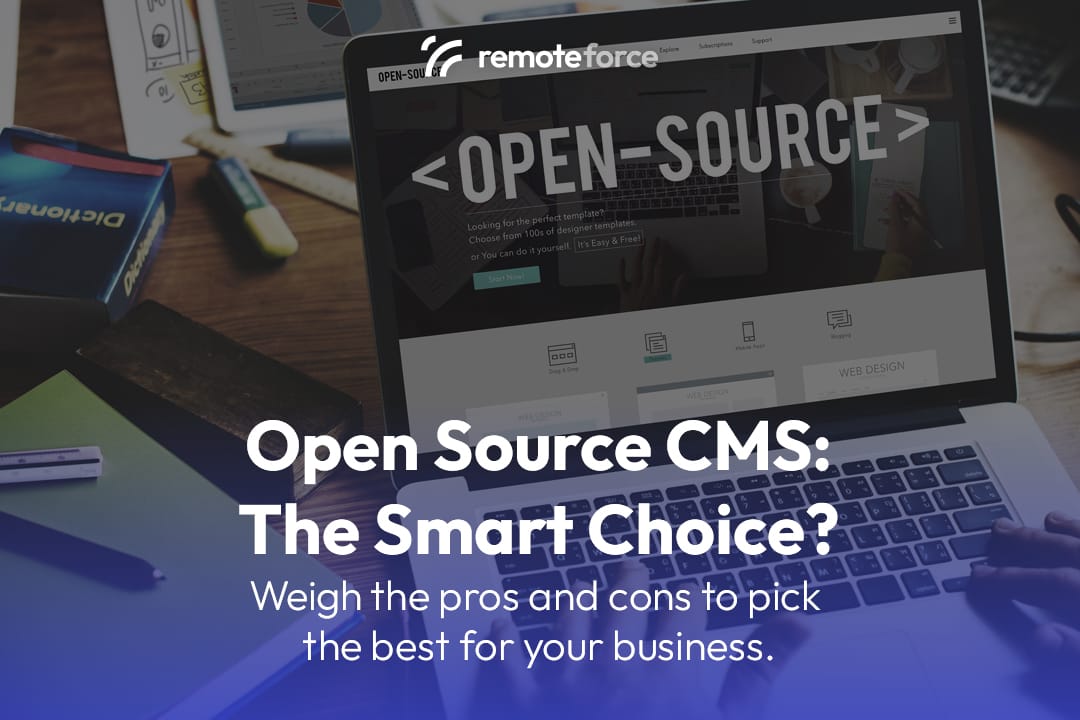Choosing the right Content Management System (CMS) is a pivotal decision for any website owner. It impacts everything from your budget and design flexibility to security and long-term scalability. Among the various CMS options, open-source CMS platforms stand out due to their unique development model and the distinct advantages (and disadvantages) they offer. Unlike proprietary software, open-source CMS provides its source code freely to the public, allowing anyone to modify and distribute it.
If you’re considering an online presence and weighing your platform options, it’s crucial to understand the pros and cons of using an open source CMS. Learning the benefits and drawbacks of open-source CMS options before choosing one for your business is essential to make an informed decision that truly fits your needs. Click to explore whether the freedom and flexibility of open-source are right for your project!
Table of Contents
ToggleKey Takeaways
Choosing an Open Source CMS is a strategic decision that pivots on balancing unlimited freedom with complete technical responsibility.
- The Core Trade-off: An Open Source CMS grants unmatched freedom, full data ownership, and limitless customization but requires the business to accept total responsibility for security, maintenance, and technical upkeep.
- Pros (Freedom): The key benefits are zero initial licensing cost, limitless customization due to access to the source code, and freedom from vendor lock-in. * Cons (Responsibility): The primary drawbacks are the steep technical learning curve required for setup and maintenance, reliance on community support (instead of dedicated support), and hidden costs associated with hiring developers and premium hosting.
- Security & Vigilance: While the code’s transparency allows the community to patch flaws quickly, the owner must be highly vigilant and apply those patches immediately to protect against known vulnerabilities.
- Best Fit: Open Source is ideal for businesses with complex, unique requirements and internal technical expertise or the budget to hire a dedicated development partner.
Understanding Open Source: Community, Code, and Control
The concept of “open source” is built on collaboration and transparency. In the context of a CMS, it means:
- Free Accessibility: The core software is generally free to download and use.
- Community-Driven Development: A global community of developers, designers, and users contribute to its development, maintenance, and improvement.
- Transparency: The source code is publicly visible, allowing anyone to inspect, learn from, and modify it.
This model contrasts sharply with proprietary (closed-source) CMS solutions, where the software is owned and controlled by a single company, and users typically pay licenses and have limited access to the underlying code. The choice between these two approaches significantly impacts your long-term digital strategy.
Pros of Using an Open Source CMS

Open-source CMS platforms offer compelling advantages, particularly for businesses seeking flexibility and control.
1. Cost-Effectiveness
- Free Core Software: The most obvious advantage is that the CMS software itself (e.g., WordPress, Drupal, Joomla) is free to download and use. This eliminates initial licensing fees that are common with proprietary systems.
- Reduced Initial Investment: For many small businesses and startups, this free entry point significantly lowers the barrier to entry for building a website.
- Abundant Free Resources: The large community often develops thousands of free themes and plugins, reducing the need for custom development for common functionalities.
2. Unmatched Flexibility and Customization
- Complete Control: With access to the source code, you have the ultimate freedom to modify, extend, and customize your website to meet highly specific business requirements. You’re not limited by the features or design templates provided by a vendor.
- Tailored Solutions: If your business has unique workflows or integration needs, an open-source CMS allows developers to build custom functionalities or integrate with virtually any third-party system.
- No Vendor Lock-in: You own your website’s data and code, meaning you’re not tied to a single provider. You can migrate your site and content more easily if your needs or preferences change.
3. Strong Community Support
- Vast Knowledge Base: Open-source CMS platforms boast huge global communities of developers, users, and enthusiasts. This translates into extensive online documentation, forums, tutorials, and readily available troubleshooting resources.
- Rapid Problem Solving: If you encounter an issue, chances are someone else in the community has faced it before and a solution is available or can be quickly crowdsourced.
- Active Development: The collaborative nature ensures continuous improvement, security updates, and new features driven by real-world user needs.
4. Robust SEO Capabilities
- Inherent SEO Friendliness: Many open-source CMS platforms, like WordPress, are inherently designed with SEO best practices in mind, offering clean code, logical content structures, and customizable URLs.
- Powerful SEO Plugins: A wide array of dedicated SEO plugins (e.g., Yoast SEO, Rank Math for WordPress) provide granular control over meta tags, sitemaps, schema markup, and other critical SEO elements, allowing you to optimize your site for higher search engine rankings.
5. Innovation and Security Through Transparency
- Constant Innovation: The open-source model encourages continuous innovation, as developers worldwide contribute new ideas, features, and improvements.
- Peer Review for Security: The public nature of the code means more eyes are on it, allowing vulnerabilities to be identified and patched more quickly by the community than they might be in a closed system.
Also Read: Choosing the Right CMS for your Website Development
Cons of Using an Open Source CMS

While powerful, open-source CMS platforms also come with certain challenges that potential users should be aware of.
1. Requires Technical Knowledge and Maintenance
- Self-Hosting Responsibility: You are responsible for finding and managing your web hosting, server setup, and ongoing maintenance (backups, updates, security). This requires more technical know-how than a fully hosted solution.
- Learning Curve: While easy for basic content, advanced customization or troubleshooting often requires a deeper understanding of web development (HTML, CSS, PHP, JavaScript).
- Developer Reliance for Complexities: For intricate features, unique designs, or resolving major issues, you’ll likely need to hire a developer or agency, adding to your costs.
2. Potential Security Risks
- User Responsibility: While the community is proactive, the responsibility for securing your specific installation (plugins, themes, core updates, server) largely falls on you. Neglecting updates or using insecure plugins can leave your site vulnerable.
- Target for Attacks: Due to their popularity, platforms like WordPress are often targets for hackers. Regular vigilance and robust security measures are essential.
3. Hidden Costs and Time Investment
- Hosting Fees: While the software is free, you’ll still pay for reliable web hosting.
- Premium Themes/Plugins: While free options exist, highly specialized or premium themes and plugins often come with costs, and annual renewal fees.
- Custom Development: If you need unique features not covered by existing plugins, custom development can be expensive.
- Time Commitment: Managing updates, security, and troubleshooting can consume significant time, especially if you’re doing it yourself.
4. Scalability Challenges (Potentially)
- While powerful, scaling an open-source CMS to handle extremely high traffic or complex enterprise needs often requires significant server optimization, advanced caching, and potentially a deeper development investment compared to some enterprise-grade proprietary solutions.
5. Lack of Dedicated Support
- You typically don’t have a direct support team to call if something goes wrong. You rely on community forums, documentation, or paid third-party support services. This can be challenging for non-technical users facing urgent issues.
Pros and Cons of Using an Open Source CMS: Making Your Informed Decision
The choice between an open-source CMS and a proprietary solution depends on your specific needs, budget, technical capabilities, and long-term vision.
| Feature / Aspect | Open Source CMS (e.g., WordPress, Drupal) |
| Cost | Low initial cost (free software); ongoing costs for hosting, premium themes/plugins, and development. |
| Flexibility | High; unlimited customization potential with access to code. |
| Control | Full ownership and control over your data and site. |
| Scalability | Highly scalable with proper optimization and resources; requires more technical management. |
| Ease of Use | Generally user-friendly for content, but higher technical barrier for setup and advanced customization. |
| Support | Community-driven support; vast documentation, forums; paid third-party support available. |
| Security | Dependent on user’s vigilance for updates and security practices; high target due to popularity. |
| Best For | Businesses needing high customization, unique features, control over their data; developers, larger teams with technical expertise. |
Conclusion: Balancing Freedom with Responsibility
Understanding the pros and cons of using an open source CMS is key to making a strategic decision for your digital foundation. Open-source platforms offer incredible freedom, flexibility, and cost-effectiveness, empowering businesses with full control over their online presence and the ability to build truly unique solutions.
However, this freedom comes with responsibility, requiring more technical involvement, vigilant maintenance, and a proactive approach to security. For businesses with the right technical resources or a willingness to invest in expert development, an open-source CMS can be an unparalleled engine for growth and innovation.
If you’re weighing your options for a new website or considering migrating your existing platform, navigating the complexities of CMS selection and its implications for development, security, and scalability can be daunting. At RemoteForce, we specialize in comprehensive web and app development services, with extensive expertise in open-source CMS platforms like WordPress and Drupal.
Our team can help you assess your needs, build custom functionalities, optimize for performance and security, and ensure your chosen open-source solution becomes a powerful asset for your business. Beyond web and app development, RemoteForce also offers digital marketing, graphic design, secretarial, legal, and accounting services, providing a holistic suite of solutions to empower your entire business.
Ready to explore if an open-source CMS is the perfect fit to power your business’s online success? Contact RemoteForce today for expert web development consultation!
Frequently Asked Questions (FAQ)
1. What is the fundamental difference between Open Source and Proprietary (Closed Source)?
The fundamental difference is access to the source code. In Open Source, the underlying code is free and public, allowing anyone to modify and distribute it. In Proprietary (Closed Source), the code is owned by a single company and is kept secret, meaning you can only use the software as intended by the vendor and must pay for a license.
2. What kind of hosting is best suited for an Open Source CMS?
For serious business websites, Managed CMS Hosting or a Virtual Private Server (VPS) is best. Avoid cheap shared hosting, as Open Source platforms (especially large ones like WordPress or Drupal) require dedicated resources, high performance, and server-side optimization to run securely and scale effectively.
3. How can I ensure my Open Source site remains secure and prevent attacks?
The best strategy involves three key areas:
- Immediate Updates: Apply core, theme, and plugin security updates immediately upon release.
- Regular Backups: Implement automated daily backups to allow for quick recovery if a breach occurs.
- Security Layers: Use a strong security plugin (like Sucuri or Wordfence for WordPress) and/or a Web Application Firewall (WAF) provided by your host or a service like Cloudflare.
4. If I choose an Open Source CMS, what is the risk of a developer or community project becoming inactive?
The risk is generally low for major platforms (like WordPress, Drupal, Joomla) due to their massive communities and enterprise adoption. However, a popular third-party plugin or theme could become inactive. The risk here is that you may not receive future security updates for that component, forcing you to find an alternative and potentially pay a developer to replace the function.




